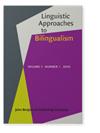遗产词汇中的长期发展
IF 1.8
2区 文学
0 LANGUAGE & LINGUISTICS
引用次数: 0
摘要
对学龄期遗产语言习得的研究表明,形态句法和词汇的发展和早期稳定是长期的。我们的研究考察了结果动词复合词(RVC)的特性,这是一种处于词法和语法交汇点的结构,它的使用者是英国的第二代遗产语儿童,他们从出生起就持续接受汉语普通话的输入。我们分析了传承儿童(n = 27,4-14 岁)及其父母(n = 18)在口头叙述任务中产生的三个子类的 RVC,并与现有数据库中北京儿童(n = 48,4-9 岁)的 RVC 进行了比较。我们的研究结果表明,传统儿童的 RVCs 相当频繁和生动,但重复性和保守性很高,他们的 RVCs 中有很大一部分是由英语中具有直接词性等价物的强词性子类组成的。相关分析表明,遗产儿童的 RVC 随年龄增长而提高,而不是随父母输入的 RVC 的提供而提高,这表明累积输入在 RVC 习得中的作用。总体而言,遗产普通话中 RVC 的发展是延迟的,而不是稳定或衰减的,这支持了精通遗产普通话者语法弱点的词汇解释。本文章由计算机程序翻译,如有差异,请以英文原文为准。
Protracted development in the heritage lexicon
Research on heritage language acquisition at the school age has shown protracted development and early stabilisation in morphosyntax and the lexicon. Our study examined the properties of resultative verb compound (RVC), a structure at the crossroads of the lexicon and morphosyntax, in second-generation child heritage speakers in the UK who had continuous input in Mandarin Chinese since birth. We analysed three subclasses of RVCs produced by the heritage children (n = 27, age 4–14) and their parents (n = 18) in an oral narration task and compared them with those by children in Beijing (n = 48, age 4–9) from existing databases. Our results show that the heritage children produced RVCs quite frequently and felicitously yet highly repetitively and conservatively, with a remarkably large proportion of their RVCs consisting of a strongly lexicalised subclass with direct lexical equivalents in English. Correlational analyses show that the heritage children’s RVCs improve with age, rather than provision of RVC in the parental input, indicating the role of cumulative input in RVC acquisition. Overall, the development of RVC in heritage Mandarin is delayed rather than stabilised or attrited, supporting the lexical account for grammatical vulnerabilities in proficient heritage speakers.
求助全文
通过发布文献求助,成功后即可免费获取论文全文。
去求助
来源期刊

Linguistic Approaches To Bilingualism
Social Sciences-Linguistics and Language
CiteScore
3.20
自引率
9.10%
发文量
24
期刊介绍:
LAB provides an outlet for cutting-edge, contemporary studies on bilingualism. LAB assumes a broad definition of bilingualism, including: adult L2 acquisition, simultaneous child bilingualism, child L2 acquisition, adult heritage speaker competence, L1 attrition in L2/Ln environments, and adult L3/Ln acquisition. LAB solicits high quality articles of original research assuming any cognitive science approach to understanding the mental representation of bilingual language competence and performance, including cognitive linguistics, emergentism/connectionism, generative theories, psycholinguistic and processing accounts, and covering typical and atypical populations.
 求助内容:
求助内容: 应助结果提醒方式:
应助结果提醒方式:


